The reason we and other car enthusiasts have a soft spot for Honda is not because it makes the Accord or ordinary versions of the Civic. At its most appealing, Honda is the kind of company that gave us the NSX and has the passion to go racing at the Isle of Man TT.
It’s the Honda that, when other car makers were fitting catalytic converters but still couldn’t meet US Clean Air Act rules, made an engine so clean that it passed the tests without an exhaust catalyst. It’s the Honda that has even grown a shorter, hardier grain of rice, whose harvest is less affected by bad weather. Honda at its best is innovative and thoughtful. It tasks small teams of talented and often young engineers to think radically and wilfully differently, in order to create something that hasn’t been created before.
Because it’s one of the world’s largest carmakers, things can’t always be like that – it also needs to make boring cars that sell - but the HondaJet, the light private jet you see here, is true to Honda’s roots. Its story epitomises the spirit of the company’s maverick founder, Soichiro Honda, to the core.
Honda puts a lot of stock in future R&D. It first looked into small aircraft and engines in 1986, and its first prototype light jet, the MH-02, was constructed in 1993. Honda’s first turbofan engine, the HFX-01, had 70 hours of testing in 1996. It wasn’t until the turn of the century, however, that Honda began testing a new small turbofan engine and established a research facility in the United States, from where the first prototype HondaJet took its maiden flight in 2003. Even then, though, production was by no means a certainty. In fact, Honda and GE Aviation announced they were to commercialise just the engine in 2004, and it wasn’t until after the HondaJet’s first public outing, at Oshkosh air show in 2005, where its reception was overwhelming and customers tried to place orders on the spot, that Honda’s board gave the green light for sales.
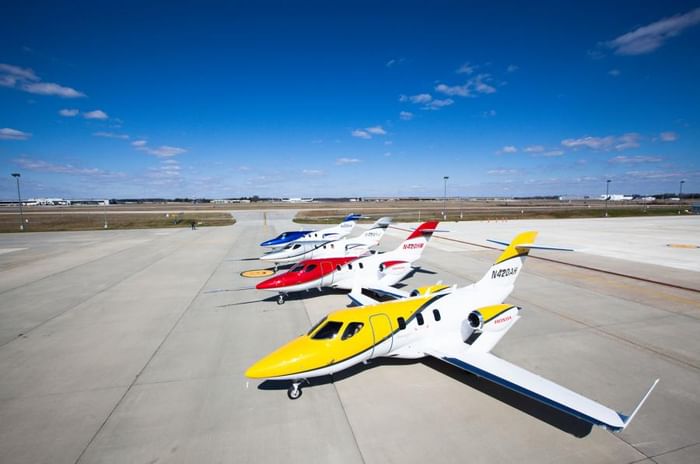
Design and engineering
Aircraft take a long time to develop, and Michimasa Fujino, the father of the HondaJet, was the kind of young, talented engineer who was a natural to excel at Honda when he was first tasked with researching small aircraft and jet engines. That was as long ago as 1986.
Fujino’s research – and in the beginning, it was purely research – culminated in the development of the experimental MH-02 aircraft. Even in that aeroplane, which has high-mounted wings and engines mounted atop them, you can see Fujino’s radical thoughts on how to improve a very light jet.
Most private jets didn’t look like the MH-02. And, indeed, most don’t look like the production HondaJet. Most, for example, have engines attached to the fuselage, for some sound engineering reasons. Forgive us while we outline those in detail, because they are key to the existence of the HondaJet. If Honda wasn’t going to do things differently, it wasn’t going to do them at all.
Light jets are small and their wings are close to the ground, so there isn’t room to mount the engines beneath them. The landing gear would be tall and the cabin would be too far from the ground for a small, plane-mounted ladder to reach it.
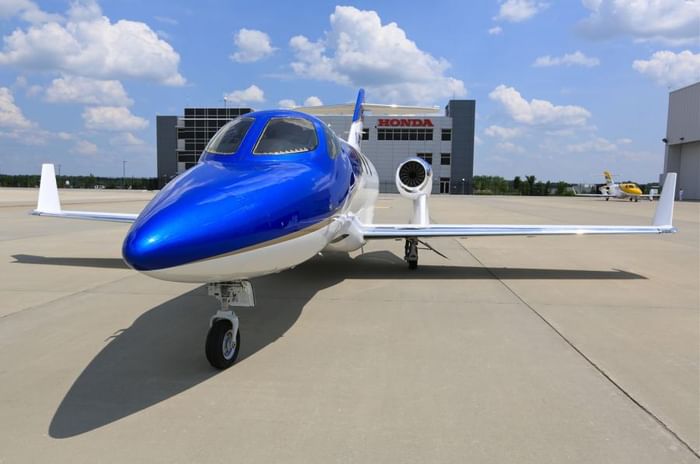
You can get around this by mounting the wings high, as on the MH-02 and some other small passenger planes, but the structural supports for the wings then stretch into the cabin space, just where you don’t want it to; they limit headroom in what is an already compact passenger compartment. Additionally, mounting the engines above the wings is fraught with associated problems, such as reduced lift and a problem called flutter.
These two problems kept Fujino turning at night, until he woke with an idea, grabbed the nearest pen and piece of paper – the back of a calendar, which he still has today – and began sketching.
Despite the scepticism, he would find a way to make engines work on top of a jet’s wings. That way he could make a private plane that was more spacious inside yet faster and more fuel efficient than any of its competitors. He would finally have a reason to build the HondaJet.
Then he’d just have to convince the management at Honda that he should do so. That Honda sees itself as a mobility company, and its board was persuaded by Fujino’s arguments, is how you’re able to read this story.
Interior
Private jets are luxury goods, but that doesn’t always mean they’re luxurious. Because their cabins are compact, seating positions and, particularly, lavatories can be smaller than the posh seats found on commercial aircraft.
The HondaJet aims to change all that, increasing cabin space by 20 per cent over other light aircraft and ensuring that passengers’ feet wouldn’t overlap each other when they have a ‘club’ seating arrangement (in which four passengers, two either side of the central aisle, face each other, behind two forward-facing seats).
The result is achieved by giving each passenger an extra 177mm of legroom over the class norm, and because more space behind the passenger compartment is allowed by the absence of two engines, there is a full-width lavatory compartment with two skylights. Behind that there’s an externally accessed baggage hold, whose design owes as much to golf bags as does the boot of most coupés – although here it can hold six bags rather than the car’s prerequisite two.
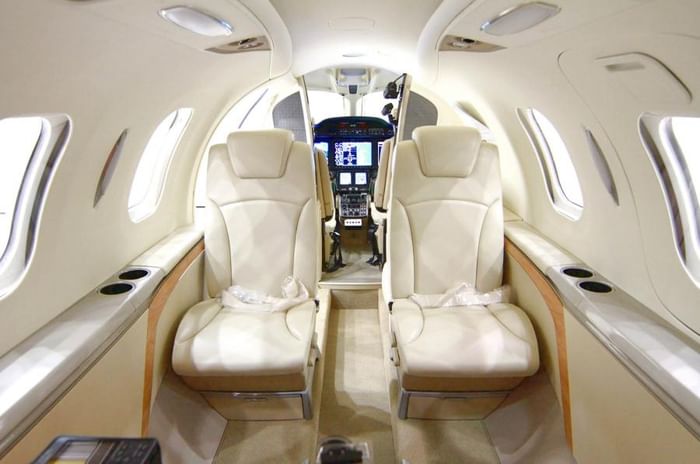
Honda, however, estimates that 50 per cent of HondaJet buyers will own a pilot’s licence and, not unlike Rolls-Royce cars, reckons that the easier and more pleasurable you make it to pilot the vehicle yourself, the more chance there is of owners occupying the front seats.
So Honda specified something practical yet truly revolutionary: a Garmin G3000 avionics suite that comprises three 14-inch landscape displays in front of the pilots, plus two (one each) glass touchscreen controllers between the front seats. As with car multimedia systems such as BMW’s iDrive, the idea is to bring as much information to the pilot as possible with the minimum of clutter. There are still analogue controls for the basics, however, plus the flight control systems – yokes, pedals and so on – and two engine start buttons that wouldn’t look out of place on the dash of a Civic Type R.
Performance
If you think designing an airframe is difficult, you should try designing an engine to go with it. Which is why, even though it is the most prolific engine manufacturer in the world, Honda enlisted a spot of help from GE Aviation, a subsidiary of General Electric, the world’s largest producer of jet engines. The people there can sell you anything from a small jet for a light aircraft through to a gas turbine for a battleship.
Even then, though, Honda couldn’t quite bring itself simply to specify an off-the-shelf unit, so it established the GE Honda engine company – a 50/50 joint venture between the two firms.
The engine they’ve co-developed, the HF120, is largely conventional in design. But it’s still unusual, mostly because it occupies a small niche, making 2050lbf of thrust. There aren’t many engines available with that kind of output because, until recently, the market for personal jets had been quite small. Now, however, it is growing at a terrific rate.
The plan for now is to build trust and confidence, not only with HondaJet customers but also with other aircraft makers. So the HF120 is a pretty understated, unremarkable unit, albeit one that’s very quiet, other than for one factor: it can go 5000 hours between overhauls, which is up to twice as long as many aero engines.
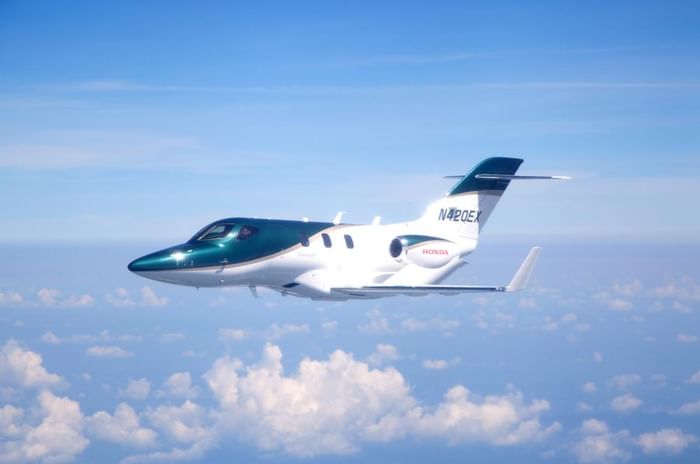
When it comes to its performance and efficiency, though, the important number to know is the specific fuel consumption, which is a measure of how much fuel it uses per hour, per pound of thrust, at a given output. The lower the number, the better.
These figures aren’t tested in a lab and published like a car’s fuel economy figure, because they change according to altitude and pressure and so on. So Honda says the HF120’s specific fuel consumption will be less than 0.7, where a leading rival’s might be less than 0.5. But even if you assume that all things are equal, which they might not be, at a given output, the design of the HondaJet will allow its engines to propel the plane faster than those of a rival.
So you might use more fuel per hour, but given that the HondaJet’s cruising speed is 420 knots, when the class average is more like 350 knots, you’ll be in the sky for fewer hours. Winding back the engine power improves its efficiency, too, to the point where Honda reckons the HondaJet is 20 per cent more fuel efficient than its competitors. It’s a deliberate choice that is made possible by the design of the aircraft, rather than the design of the engine.
Ride and handling
Quite a lot of cars are air sprung, but not even a Mercedes S-class rides on a carpet of air in quite the same way as a HondaJet. So it’s as comfortable as conditions allow a very light jet to be. And the HondaJet is light.
Its fuselage is made from composites rather than aluminium, which has obvious weight and some less obvious stiffness characteristics. And while the central fuselage is a constant radius (allowing the design to be stretched to create larger variants later), you’ll notice that there’s a slight bulge around the cockpit, to improve visibility on the ground.
The carbonfibre material has a honeycomb construction at the nose and tail, essential for precisely moulding a complex shape that retains laminar airflow. The same laminar flow is maintained over the wings, which are aluminium.
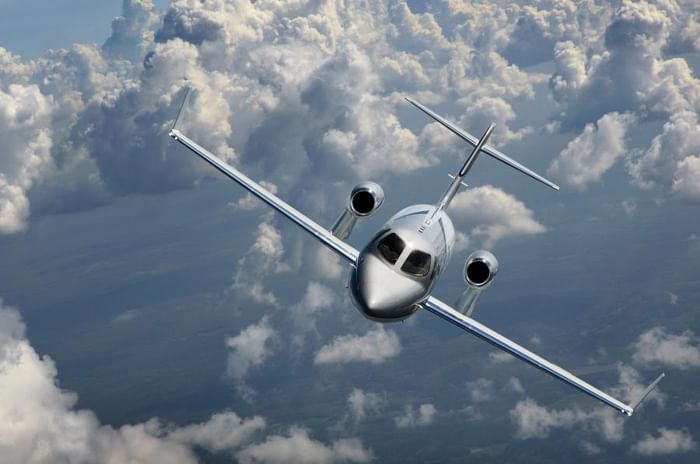
Retaining laminar flow over the wing is traditionally particularly difficult, because wings are where you store the fuel. Wings of a large span compared to their length (from front to rear, viewed from overhead) are good for drag; they’re said to have a high aspect ratio. But because they’re narrow, they can’t store much fuel. The HondaJet has two large, vertical winglets, which act to maintain the aspect ratio of the wings of a much wider aircraft. At just 12.12m wide, however, it still fits inside a conventional hangar.
The compact, low-drag shape makes the HondaJet cruise and accelerate easily while, according to its pilots, it handles with the agility you’d expect of a very light jet. The drag coefficient is as little as 0.032 at lower speeds, rising to just 0.052 at Mach 0.84. Any car whose drag figure starts with 0.2 can be proud, so the HondaJet is very slippery indeed. It also climbs at an impressive rate of 3990 feet per minute.
Verdict
The HondaJet epitomises everything we love about Honda. The jet has been a laborious, slow-burn project whose leader has had to jump through multiple hoops and face multiple challenges in order to get the corporation to agree to put the aircraft into production, but in doing so it reveals that, deep down, Honda still has the old sparkle of Soichiro at its core.
Faster, lighter, more efficient and just more radical and interesting than the competition, the HondaJet is how, if we were bright enough to forge ourselves proper career as technology start-up billionaires or good old-fashioned rock stars, we’d do our long-distance travelling.




















































































